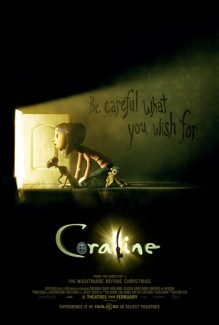Coraline (Henry Selick, 2009): USA
Reviewed by Richard Feilden. Viewed on DVD
 Following on from My Bloody Valentine, this is the second in my impromptu series of 3D films viewed in glorious flat-o-vision, and I’m moving from horror to children’s films. It isn’t as much of a swerve as you might think, as Coraline was originally conceived and written by Neil Gaiman, the celebrated author of classic paranormal graphic novels including the Sandman series, as well as 2005’s movie Mirrormask. This is a fairy tale has more in common with Roald Dahl than Walt Disney, and director Henry Selick has instilled it with the same joy of the macabre as his previous stop-motion classic, The Nightmare Before Christmas. Coraline is a deliciously creepy tale of good versus evil that will enchant and delight young and old.
Following on from My Bloody Valentine, this is the second in my impromptu series of 3D films viewed in glorious flat-o-vision, and I’m moving from horror to children’s films. It isn’t as much of a swerve as you might think, as Coraline was originally conceived and written by Neil Gaiman, the celebrated author of classic paranormal graphic novels including the Sandman series, as well as 2005’s movie Mirrormask. This is a fairy tale has more in common with Roald Dahl than Walt Disney, and director Henry Selick has instilled it with the same joy of the macabre as his previous stop-motion classic, The Nightmare Before Christmas. Coraline is a deliciously creepy tale of good versus evil that will enchant and delight young and old.
Our heroine, Coraline, is a little girl with loving, but busy, parents. She wants to garden in the rain, they want to write a plant catalogue in peace. Bored and lonely, having rejected the company of her landlady’s grandson and his cat, she discovers a tiny door that leads to an Other world. There, she finds her Other Mother and Other Father, living in a house just like hers, only better. Her Other Mother and Other Father dote upon her, lavishing her with gifts, delicious food and, most importantly, attention. But, of course, there is a price to pay.
The best animated films succeed not because of the medium, nor in spite of it. From Bambi through to Toy Story, each succeeds because the tale is well crafted. Coraline finds success in the same way. While the animated style enhances the film’s ability to carry us on its wildest flights of imagination, as well as giving complete creative control over the style and images, Coraline’s tale could stand proud (and obviously has done with Gaiman writing the original novel) in another format. One of its greatest strengths lies in its detailed characters. Coraline Jones’ depth comes from more than a pair of red and green filters. Gaimen and Selick have made her loveable but flawed, and Dakota Fanning brings her churlishness, arrogance and fear to life, as well as her nobler traits. You’ll forget that she is a doll, long before this film is through. Her parents, voiced by John Hodgman and Teri Hatcher, might not get quite the same level of nuance, but they to work very well. They aren’t bad people at all; they are just busy, finding it hard to find time for their daughter. I’ve seen plenty of ‘real’ people in films who were less believable than these mannequins.
The animation itself is stunning, as might be expected from Selick. The work is even more impressive than Nightmare, with the human faces being wonderfully expressive. It also works perfectly in two dimensions. At the start of the film I noticed occasions where the film was obviously using (abusing?) the gimmick of 3D, but these quickly vanished. That isn’t to say that there weren’t later moments that were designed to take advantage of the virtual depth that Real D provides, but they were slipped in gracefully and the film worked perfectly as a two dimensional production.
So, my second dip into the 3D/2D pool was a world away from the first. I may not have been immersed in the film’s virtual realm, but I was immersed in the tale, and that, not binocular vision, is the important thing. Some have suggested that this film might be too dark for children, but I think that, apart from the very young, they’ll be fine. Of course, the first film that I ever saw in a theater was Watership Down – a cartoon about fluffy bunnies adapted from a novel. It’s also a tale of murder and betrayal, with rabbits fighting to the death in a whirlwind of spit and blood. It is far scarier than this film and I survived just fine! Sure, children might grab a cushion to hide behind, but they won’t be able to take their eyes off the screen, and neither will you.
22 Comments
Jump to comment form | comments rss [?] | trackback uri [?]